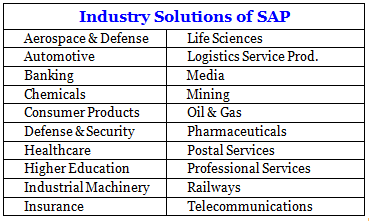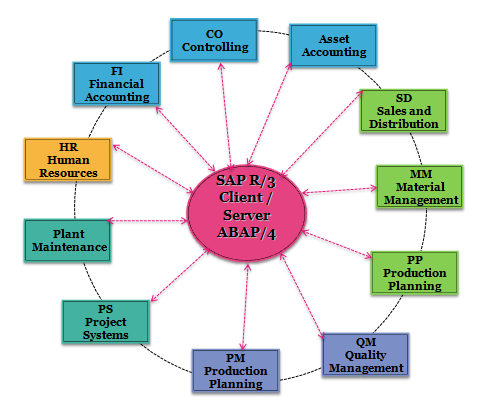The following SAP tutorial will guide you through everything about SAP definition history, important functionals & technical modules, integration, architecture, and why SAP was successful.
If you are new to SAP, the first question that arises in our mind is, “What is SAP? and what does SAP stand for?. Let discuss briefly about SAP software.
What is SAP (Systems Applications Products)?
SAP stands for Systems, Applications, and Products in Data Processing.
- SAP is the fourth largest software company in the world – www.sap.com
- The SAP R/3 system is a business software package designed to integrate all areas of a business.
- It provides end-to-end solutions for financials, manufacturing, logistics, distribution, etc.
- All business processes are executed in one SAP system and share common information with everyone.
So, What is SAP – SAP is an Enterprise Resource Planning (ERP) system by SAP AG, a company based out of Walldorf in Germany. AG is derived from the German word Aktiengesellschaft. According to German Language SAP Stands for Systeme, Anwendungen und Produkte in Der Datenverarbeitung. An SAP software suite that is being implemented as part of re-engineering and Provides end-to-end solutions for financial, logistics, distribution, and inventories. Present scenario large number of companies are using sap software for their day-to-day business activities.
History of SAP Software
SAP was Founded in and around 1972 by five IBM engineers Hopp, Wellenreuther, Hector, Tschira, and Plattner.
- SAP R/1:– The first version of SAP software was launched in and around 1972 known as the “R/1 system. R” stands for real-time data processing. it is one tier architecture in which three layers Presentation, Application, and Database are installed in one system/server
- (One – Presentation + Application + Database)
- SAP R/2:– In 1979 second version of SAP R/2 was released. with IBM’s database and a dialogue-oriented business application. SAP R/2 to handle different languages and currencies. R/2 is 2 tier architecture in which three layers of Presentation, Application, and Database are installed in two separate servers.
- (Server one – Presentation, Server two – Application + Database
- SAP R/3:– SAP upgraded R/2 to R/3. SAP R/3 is the client/server version of the software and it is 3-tier architecture in which three layers of Presentation, Application, and database are installed in three servers/systems.
- Server one – Presentation, Server Two – Application, server Three – Database
- SAP Hana DB– In the year 2010, a new version of SAP Hana has been released. SAP Hana (High-Performance Analytic Application) is a memory computing database. The latest version of Hana is SAP S4 Hana 2024.
Products of SAP
- SAP R/3 and R/3 Enterprise
- mySAP Business Suite
- SAP ERP
- SAP Industry Solutions
- SAP xApps
- SAP Solution Manager
Industry Solutions of SAP
SAP R/3 – Modules & Integration
SAP Functional Modules
- FICO – Finance & Control
- PP – Production Planning
- MM – Material Management
- SD – Sales & Distribution
- WM – Warehouse Management
- QM – Quality Management
- HR – Human Resources
- CRM – Customer Relationship Management
SAP Technical Modules
- ABAP – Advanced business applications programming
- XI – Exchange Infrastructure
- Net viewer
- Basis
- BIW – Business Information Warehousing
What is SAP FICO?
SAP FICO Stands for FI (Financial Accounting) and CO (Controlling). It is an important module of ERP and both Finance and Controlling modules store the financial transaction data. The ‘FI (Financial Accounting)’ records, collects, and processes financial transactions or information on a real-time basis to provide the necessary inputs for external (statutory) reporting purposes. SAP CO plays an important role in management decision-making purpose and internal reporting purposes. Continue to read for SAP FICO
FICO contains the following sub-modules.
| FI | CO |
| General Ledger accounting | Cost Element Accounting |
| Accounts Receivables | Cost Center Accounting |
| Accounts Payable | Profit Center Accounting |
| Asset Accounting | Internal Orders |
| Bank Accounting | Product Cost Controlling |
| Consolidation | Profitability Analysis |
| Special Purpose Ledger | |
| Travel Management |
What is SAP MM?
SAP MM ( Material Management ) is one of the imp modules in SAP ERP software and it supports the procurement and inventory functions occurring in day-to-day business operations. This MM module contains many aspects such as purchasing, goods receiving, material storage, consumption-based planning, and inventory. SAP MM module is fully integrated with other modules in the SAP R/3 System such as FICO, SD, QM, PM, PP, and WM.
What is SAP PP?
The Production Planning application module is used to plan and control the manufacturing activities of a company. consists of all system configuration, master data, and complete solutions to the production process.
What is SAP SD?
SAP SD ( Sales and Distribution ) is an important module of SAP and it is a part of logistics. The main activities of SD are sales order handling, distribution of shipments to customers, the billing process, customer invoices, and delivery. SD module is fully integrated with other modules in the SAP R/3 System such as Finance, Purchasing(MM), and Production Planning(PP).
What is SAP HR?
SAP Human Resources manages the complete employee life cycle and payroll. All aspects are covered from training to appraisal. Continue to read for SAP Human Capital management
Advantages of SAP:-
- SAP software manages these business management tasks in modules that all work together in one system by sharing information.
- Promoting consistent practice across an entire division
- No duplicate data
- Automate Project Monitoring and Multidimensional and flexible reporting
- Standardization of business processes
- Make Planning, Scheduling, Tracking, and Management easier leaving more time for you to perform value-added work
- Ability to provide clear-cut job roles with authorizations
- Enabling integration with e-commerce
- Cost Savings on overheads such as Stationery, File Storage, etc.
Why – SAP R/3 software has been successful
- Multi-Lingual
- Secure Information
- Multi-Currency
- Best Business Practice
- Enterprise-Wide
- Real-time processing with an integrated suite of client/server applications
SAP R/3 Architecture
SAP System is based on three layers such as Presentation Layer, Application Layer, and Database Layer.
- Presentation: – It is a layer where the user works with SAP GUI. It interacts with the database layer via the Application layer.
- Application: – It interacts between the presentation and database layer
- Database: – It is a central database that stores all the data of ERP SAP Systems.
SAP System Landscape
Every SAP Implementation project goes through deployment phases. The SAP system landscape included the following environments
- Development System
- Test and Quality Assurance System
- Production System

SAP Business Suites
SAP offers various applications along with the ERP SAP to meet customer requirements. The important applications of SAP are as follows.
- SAP Supply Chain Management (SAP SCM)
- SAP Customer Relationship Management (SAP CRM)
- SAP Product Life Cycle Management (SAP PLM)
- SAP Supplier Relationship Management (SAP SRM)
- SAP Advanced Planning and Optimization (SAP APO)
Phases of SAP Implementation Project:
The following are the phases of the SAP ECC implementation project.
- Phase 1 – Project Preparation,
- Phase 2 – Business Blueprint,
- Phase 3 – Realization,
- Phase 4 – Final Preparation,
- Phase 5 – Go Live and support
In SAP S4 Hana, the implementation project is managed through methodologies like Activate Methodology, Agile Methodology, etc.
>>> If you are new to SAP, read our SAP tutorials for beginners that explain with step by step with screenshots.


